
Researching Canadian Soldiers of the First World War
Part 4: War Diaries and Unit Histories
By Michael O'Leary; The Regimental Rogue
Updated: 19 Sep 2022
Once you have acquired the service record for your ancestor, and examined it for the dates he arrived at and left various units, you can now start to focus research efforts into the activities of those units while he served with them. Unless you have letters the soldier sent to family and friends, you may be limited to gaining a general understanding of the unit's activities to generalize his experiences. Without being able to place him specifically in a certain company or platoon at particular times, it will be difficult to narrow your area of study with precision. To examine the wartime activities of units of the Canadian Expeditionary Force (CEF), we can seek out War Diaries and unit histories.
War Diaries
Each unit of the CEF in the theatre of war (i.e., France and Flanders) was required to complete, in monthly submissions, a War Diary. The war diary consists of daily entries summarizing the unit's activities for that day, and the monthly record was usually supplemented by the addition of orders or other communications sent or received, maps, and other paperwork considered worthy of retention or that supported the diary's content. The Library and Archives Canada (LAC) provided a good description of the War Diaries, which included this passage:
"These are NOT personal diaries. War Diaries rarely record information about individual men because they were never intended to document individual service, and also due to the size of the unit to which a single War Diary referred. Infantry Diaries were recorded by battalions, which consisted of approximately 1,000 men. Artillery Diaries were most often kept by brigades, which numbered about 4,000 men. Command-level diaries recorded tactical and strategic information. Even so, once you have identified the unit in which you are interested, War Diaries provide the most complete first-hand record of how and where that unit was deployed and the wartime experiences of its individual members.
Units were only required to record their "Actions in the Field." Therefore, you will find very few Diaries for periods during which units were mustered in Canada, shipped to Europe, or trained in England. With this in mind, the contextual material that was prepared for this Web site, identifies the units that fought in a select number of battles. However, this is not the only way to access the Diaries. The search functions on this site make it possible for researchers to follow units from month to month, or to see the first-hand experiences of a single day.
For War Diaries of units of the Canadian Expeditionary Force, we return to the Library and Archives Canada Collection Search page.
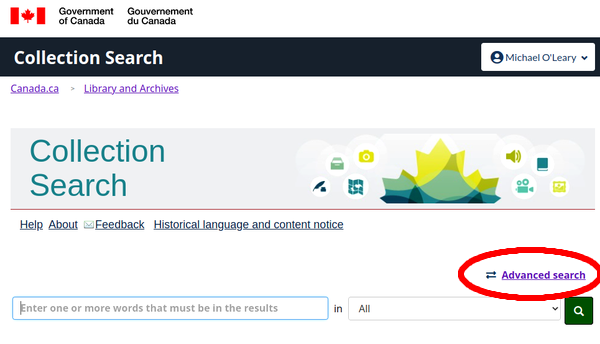
The basic search form for Collection Search at the Library and Archives Canada website.
An alternative and more efficient War Diary search capability, courtesy of the Canadian Great War Project, is described below.
In the LAC Collection Search, there is no dedicated database search for the War Diaries. The efficiency of your search will depend upon the accuracy of your search terms. Note that the results are catalogued with "War diaries" and the full unit title.
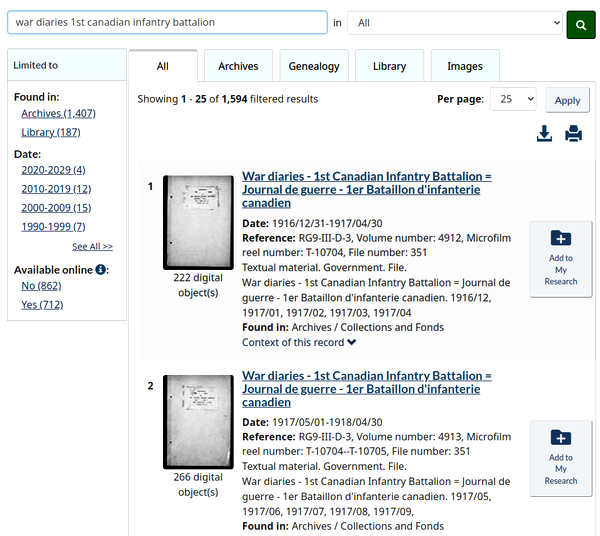
LAC Collection Search results for war diaries 1st canadian infantry battalion.
Start with "war diaries" as your main search term, then add the unit name. Dates can be added to the initial search, or refined by selecting the decade to narrow the selection after the first search is made. The database search results lead to set of page images for the relevant war diaries. The war diaries have not been transcribed and cannot be searched for text. Each war diary has been made available as individual page images, some of which are typewritten and some of which are hand written.
Searching with dates can miss results depending on how dates have been added to the database for individual document sets. It is more effective to determine the exact unit name and search with that. Start with a generic name for the unit (e.g., 2nd Battalion) and examine the results to narrow and refine your search. You may find that a search for 2nd Battalion is too generic, including all of the following units:
- 2nd Canadian Machine Gun Battalion
- 2nd Canadian Infantry Battalion
- 2nd Battalion, Canadian Mounted Rifles
- 2nd Reserve Battalion
- 2nd Battalion, Canadian Engineers
- 2nd Canadian Engineers Reserve Battalion
- 2nd Infantry Works Battalion
- 2nd Entrenching Battalion
- 2nd Pioneer Battalion
- 2nd Battalion, Canadian Railway Troops
Reduce the number of returns by filtering by date (decade) and for online documents. The early sets of result may also indicate how the unit title might be more accurate for your search.
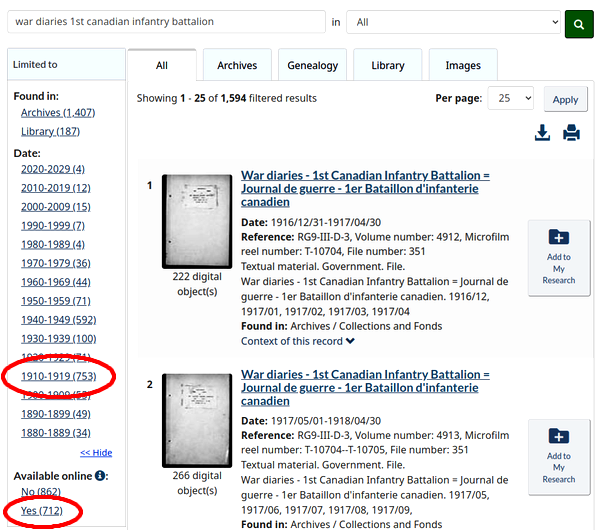
Narrow the results by selecting the desired decade and for online documents.
From this one example, it becomes obvious that knowing exactly which unit you are researching is a critical piece of information.
Choosing a linked result will open a viewer that allow you to scroll through the pages of the War Diary, zoom in on them and move the pages around to read them. For most researchers, it will be more efficient to download the files to your own computer for access.

Library and Archives Canada document viewer, 1st Canadian Infantry Battalion War Diary (1916/12/31-1917/04/30).
If you are continuing to have difficulty finding the right War Diary, you may find some assistance through the CEF Study Group in their forum section War Diary Transcripts. There is also the Study Group's Wiki Project which includes this page on War Diaries.
The amount and level of detail of content in the war diaries varies greatly. Some units probably considered the War Diary an onerous and unwelcome task and very little information was included, others seemed to have a much better sense of the war Diary as a method to capture their unit history and much detail was recorded. This also varies within individual diaries depending on the personalities of the Commanding Officer and the Adjutant, and the sense of importance given to particular activities and periods of time, and in some cases whether or not the preparatory notes survived until the Diary was compiled for the month.
The following cropped image provides a glimpse of what may be found in a unit war diary.
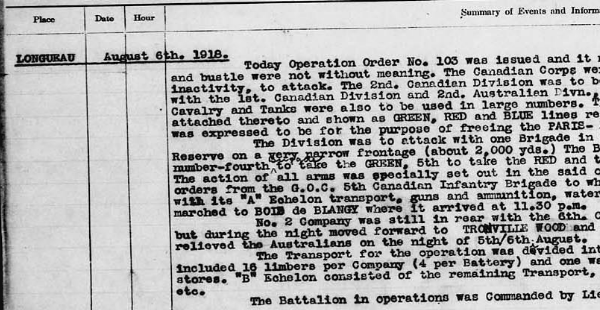
A (cropped) image of one page of the war diary of the 2nd Canadian Machine Gun Battalion. The full page may be seen here.
For each month of the war diary, examine both the recorded daily activities, but also the appendix pages. Some appendices will be orders for moves in and out of the trenches and give precise dates and locations for periods in the front lines. Other appendices may provide detailed descriptions of unit actions in battle or other details far exceeding the short notes in the war diary pages themselves.
Canadian Great War Project War Diaries Viewer
On 8 Jan 2017, the following comment was posted to the Canadian Expeditionary Force Study Group by a member of the team redeveloping the Canadian Great War Project under the University of Victoria:
I'd like to announce a sort-of soft-release of the CGWP War Diaries Viewer. The application provides a relatively simple front-end to the LAC collections and right now is indexing 750 'units' (in quotes because the segmentation used by LAC is not based on regimental names). Finding a unit is done using the type-ahead search box. It isn't a typical search engine, but I hope you'll find it easy to use.
I've tried to make it as useful to researchers as I can:
- You can constrain your search by filtering on unit AND month OR year OR both.
- You can also search for a specific month/year WITHOUT specifying a unit name (e.g. http://cgwp.uvic.ca/diaries/?m=05&y=1917)
- Search for regiments based on commonly-used names (e.g. PPCLI) or the unit that perpetuates the one you're interested in (e.g. search for '22nd' or 'deux' or 'doos' returns the 22nd Canadian Infantry Battalion) is supported – please note that right now, this feature is incomplete and inevitably contains errors (corrections and additions welcome!).
Right now (2017) we have 750 units indexed, but there are about 200 more we can add … As LAC adds more diary scans we will incorporate them. FYI, it looks like LAC only needs to scan 140 more 'collections' to complete its online holdings.
Screenshots:
The War Diaries Viewer entry page:
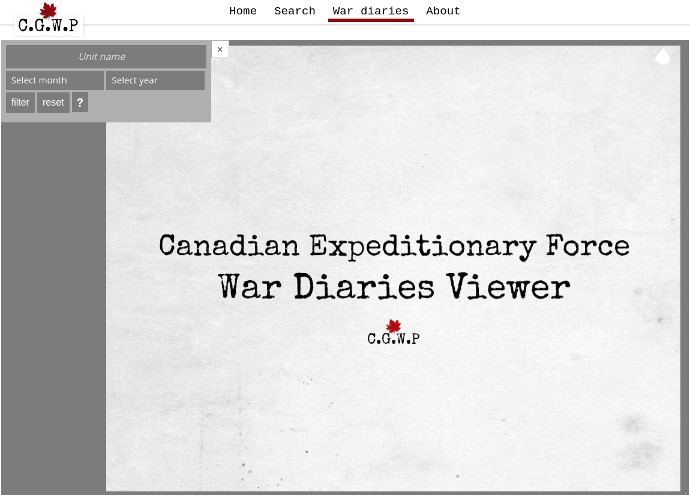
Selecting the unit and date:

Viewing a War Diary page:

Published Unit Histories
Some units of the Canadian Expeditionary Force published unit histories soon after the War, others did so later and, unfortunately, some never did so. Even today, there are researchers and authors working to fill in some of those gaps on the virtual bookshelf of unit histories, so it can be worthwhile to renew your search for information periodically.
Some published unit histories are very rare, and very expensive when found for sale. Others are more available and some have been digitized and can be found on line. Internet searches for the unit name will often result in mentions of, if not links to, unit histories. Some CEF unit histories can be found online in the Internet Archive. Another site worth searching for documents relating to your research is Google Books.

Results of a search of "CEF" and "battalion" for texts in the Internet Archive. Note the keywords associated with the third result, which can aid in further searches. This shows an older format search result, the increasing numbers of CEF documents on the Internet Archive offers both greater returns and greater search challnges to narrow results.
Where a specific unit history does not exist, you may need to search out a Corps or formation (such as that of an Artillery Brigade) history. These may provide less information specific to your soldier's unit, but will provide a good overview of tasks and activities the units undertook.
This is also an alternative to the wartime unit having published a history. Each combat unit of the Canadian Expeditionary Force (infantry, cavalry, artillery and engineers) is or was formally perpetuated by a unit if the Canadian Militia, or Permanent Force. See Perpetuation of the Units of the Canadian Expeditionary Force (C.E.F.), 1914-1919 for an explanation of perpetuation and a link to tables showing what units now perpetuate CEF battalions.
From a research persepctive, the importance of perpetuation in the research of a First World War soldier is not that a later unit in Canada represented his unit's history and honours, but that that perpetuating unit may have published a history under their own unit name which includes the history of their CEF forebears. For example, the 28th Canadian Infantry Battalion is now perpetuated by the modern day Reserve Force infantry unit the Royal Regina Rifles. The regimental history of the Royal Regina Rifles published in 1992, Up the johns! : the story of the Royal Regina Rifles, includes a chapter on the Great War, including the 28th Battalion.
The Library and Archives Canada
Guide to Sources Relating to Units of the Canadian Expeditionary Force
In the spring of 2012, The Library and Archives Canada made available to the public a thematic guide compiled over many years by one of the LAC's archivists. The Guide to Sources Relating to Units of the Canadian Expeditionary Force in introduced in the LAC's website with the following description:
The guide has a section for each military branch (or corps), such as artillery, infantry, or medical. Each corps is further sub-divided by unit, for example, the Royal Canadian Horse Artillery Brigade can be found in the artillery section, along with all the other artillery units.
Each unit contains either background information or archival sources or both. It is important to note that if one or the other is absent, this does not necessarily mean that there are no existing records related to that unit, only that they have not been referenced.
For convenience, the following list of links is reproduced from the LAC page linked above:
- Artillery (PDF, 793 KB)
- Canadian Army Medical Corps (PDF, 882 KB)
- Canadian Army Service Corps (PDF, 370 KB)
- Army Troop Companies, Canadian Engineers (PDF, 162 KB)
- Field Companies and Battalions, Canadian Engineers (PDF, 627 KB)
- Miscellaneous Units, Canadian Engineers (PDF, 126 KB)
- Pontoon Bridging Transport Units, Canadian Engineers (PDF, 145 KB)
- Signal Service, Canadian Engineers (PDF, 218 KB)
- Tramway Companies, Canadian Engineers (PDF, 153 KB)
- Canadian Forestry Corps (PDF, 609 KB)
- Canadian Garrison Regiment (PDF, 160 KB)
- Canadian Mounted Rifles (PDF, 336 KB)
- Canadian Ordnance Corps (PDF, 131 KB)
- Canadian Railway Troops (PDF, 375 KB)
- Cavalry (PDF, 363 KB)
- Cyclists (PDF, 158 KB)
- Depot Battalions (PDF, 212 KB)
- Divisional Ammunition Column (PDF, 279 KB)
- Employment Companies (PDF, 150 KB)
- Entrenching Battalions (PDF, 138 KB)
- Infantry Works Companies (PDF, 172 KB)
- Infantry Battalions (PDF, 3,020 KB)
- Labour Battalions (PDF, 163 KB)
- Machine Gun Units (PDF, 548 KB)
- Miscellaneous Infantry Units (PDF, 136 KB)
- Miscellaneous (PDF, 131 KB)
- Pioneer Battalions (PDF, 267 KB)
- Reserve Battalions (PDF, 388 KB)
- Trench Mortar Batteries and Groups (PDF, 290 KB)
- Tunnelling Companies and Canadian Engineers (PDF, 182 KB)
- Canadian Army Veterinary Corps (PDF, 176 KB)
Online Forums as Sources of Information
Another possibility to find information about your soldier's unit and its activities (as well as many other aspects of the CEF soldier's experiences) is to follow in the footsteps of those who have gone before you. Join and participate in the Canadian Expeditionary Force Study Group, or the Great War Forum, where you may find others who have researched that unit or even have details about your soldier in their own collected data. As you join these groups keep in mind that they are virtual communities, the members create and grow the group through cooperation and sharing of resources and research. While it is fully aceptable to ask questions, be as ready to share what you have with others.
Researching Canadian Soldiers of the First World War
- Introduction
- Part 1: Find your Man (or Woman)
- Part 2: The Service Record
- Part 3: Court Martial Records
- Part 4: War Diaries and Unit Histories
- Part 5: Casualties
- Part 6: Researching Honours and Awards
- Part 7: Deciphering Battlefield Location Information
- Part 8: More Mapping Information
- Part 9: Matching Battlefield Locations to the Modern Map
- Part 10: Service Numbers; More than meets the eye
- Part 11: Rank, no simple progression
- Part 12: Medals; Pip, Squeak, Wilfred and the whole gang
- Part 13: Evacuation to Hospital
- Part 14: The Wounded and Sick
- Part 15: Crime …
- Part 16: … and Punishment
- Part 17: Battalions and Brigades, Companies and Corps
- Part 18: Photo Forensics: Badges and Patches
- Part 19: Veterans Death Cards
- Part 20: The Vimy Pilgrims (1936)

- The O'Leary Collection; Medals of The Royal Canadian Regiment.
- Researching Canadian Soldiers of the First World War
- Researching The Royal Canadian Regiment
- The RCR in the First World War
- Badges of The RCR
- The Senior Subaltern
- The Minute Book
- Rogue Papers
- Tactical Primers
- The Regimental Library
- Battle Honours
- Perpetuation of the CEF
- A Miscellany
- Quotes
- The Frontenac Times
- Site Map
QUICK LINKS
- Tomb of the Unknown Soldier
- Vimy Memorial
- Dieppe Cemetery
- Perpetuation of CEF Units
- Researching Military Records
- Recommended Reading
- The Frontenac Times
- RCR Cap Badge (unique)
- Boer War Battles
- In Praise of Infantry
- Naval Toast of the Day
- Toasts in the Army (1956)
- Duties of the CSM and CQMS (1942)
- The "Man-in-the-Dark" Theory of Infantry Tactics and the "Expanding Torrent" System of Attack
- The Soldier's Pillar of Fire by Night; The Need for a Framework of Tactics (1921)
- Section Leading; A Guide for the Training of Non-Commissioned Officers as Commanders and Rifle Sections, 1928 (PDF)
- The Training of the Infantry Soldier (1929)
- Modern Infantry Discipline (1934)
- A Defence of Close-Order Drill (1934): A Reply To "Modern Infantry Discipline"
- Tactical Training in the British Army (1901)
- The Promotion and Examination of Army Officers (1903)
- Discipline and Personality (1925)
- The Necessity of Cultivating Brigade Spirit in Peace Time (1927)
- The Human Element In War (1927)
- The Human Element In Tanks (1927)
- Morale And Leadership (1929)
- The Sergeant-Major (1929)
- The Essence Of War (1930)
- Looks or Use? (1931)
- The Colours (1932)
- Personality in Leadership (1934)
- Origins of Some Military Terms (1935)
- Practical Examination; Promotion to Colonel N.P.A.M. (1936)
- Company Training (1937)
- Lament Of A Colonel's Lady (1938)
- Morale (1950)
- War Diaries—Good, Bad and Indifferent
- Catchwords – The Curse and the Cure (1953)
- Duelling in the Army
- Exercise DASH, A Jump Story (1954)
- The Man Who Wore Three Hats—DOUBLE ROLE
- Some Notes on Military Swords
- The Old Defence Quarterly (1960)
- Military History For All (1962)
- Notes for Visiting Generals (1963)
- Hints to General Staff Officers (1964)
- Notes for Young TEWTISTS (1966)
- THE P.B.I. (1970)
- Standing Orders for Army Brides (1973)
- The Time Safety Factor (1978)
- Raids (1933)
- Ludendorff on Clerking (1917)
- Pigeons in the Great War
- Canadian Officer Training Syllabus (1917)
- The Tragedy of the Last Bay (1927)
- The Trench Magazine (1928)
- Billets and Batman (1933)
- Some Notes on Shell Shock (1935)
- Wasted Time in Regimental Soldiering (1936)
- THE REGIMENT (1946)
- The Case for the Regimental System (1951)
- Regimental Tradition in the Infantry (1951)
- The Winter Clothing of British Troops in Canada, 1848-1849
- Notes On The Canadian Militia (1886)
- Re-Armament in the Dominions - Canada (1939)
- The Complete Kit of the Infantry Officer (1901)
- The Canadian Militia System (1901)
- The Infantry Militia Officer of To-day and His Problems (1926)
- Personality in Leadership (1934)
- British Regular Army in Canada
- Battle Honours (1957)
- Defence: The Great Canadian Fairy Tale (1972)
- The Pig (1986)
- Standing Orders for the Fortress of Halifax, N.S.; 1908
- Medals and Badges - Fakes and Copies
- Army Punishments Part 1 - • Part 2
• C.A.R.O. No. 6719 - Campaign Stars, Clasps, The Defence Medal and the War Medal 1939-45
[an error occurred while processing this directive]
[an error occurred while processing this directive]
[an error occurred while processing this directive]